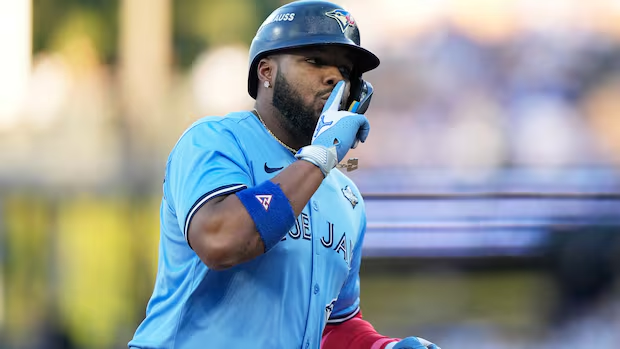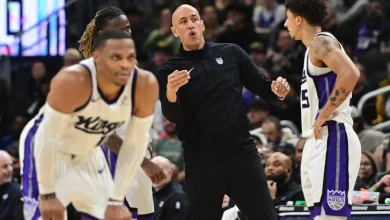If Guerrero Jr. delivers Toronto’s 1st World Series in 32 years, he’s worth whatever Blue Jays are paying him

One problem with trying to calculate, dollar for dollar, a return on the Blue Jays’ $500 million US investment in Vladimir Guerrero Jr.: hardly anyone can access the team’s actual revenue figures, and even fewer of us have the math skills to make sense of all those numbers.
The other problem is, it doesn’t matter whether, at the tail end of the last season before Guerrero’s 14-year deal takes effect, money is coming faster than the Jays can spend it on their 26-year-old superstar.
You can assign a price to a ticket – as of Wednesday afternoon, a seat in section 116 for Friday’s game at the Rogers Centre cost $4,070.43 Cdn, taxes and fees included. But, until advanced AI software masters monetizing our memories and emotions, you can’t put a dollar value on the feeling that came with watching Guerrero launch a Shohei Ohtani breaking ball over the left field fence to put the Jays ahead in Game 4. It’s another remember-where-you-were-when-it-happened moment in a post-season full of them.
So if Guerrero leads the Blue Jays to a World Series title this weekend, you can already call it even on his half-billion-dollar contract.
Ticket sales, TV ratings, value of the brand – they’ll all climb. Vindication for a long-suffering fan base, in a city where few people younger than 40 can remember a World Series winner, and where the most recent Stanley Cup is nearly old enough to qualify for CPP payouts, is worth something, too. And it’s all unfolding in a pro sports industry where teams routinely pay out lavish sums for long-shot rewards.
In that context, in 14 years, the $500 million the Blue Jays committed to Guerrero Jr. might look like a bargain.
Consider that the 2025 season began amid uncertainty about Guerrero Jr.’s long-term future with the club. He wanted a contract extension, and he wanted it settled before spring training. The Jays maintained they wanted to keep him, but training camp started without a deal, an indication the two sides disagreed on money, contract length, or both.
Dodgers pitcher Shohei Ohtani (17) watches Toronto Blue Jays’ Vladimir Guerrero Jr.’s two-run home take flight during the third inning of Game 4 in Los Angeles. (AP Photo/David J. Phillip) (David J. Phillip/The Associated Press)
Uncomfortable limbo
They all reached opening day in an uncomfortable limbo. The superstar player signalling to fans that he wanted to stay, and the club thrust into the awkward position of employing a standout they might not plan to keep, and not minding if he turned in a lacklustre 2025. It would either drive down the price of re-signing him, or soften the blow of watching him leave in the off-season.
In early April the impasse cracked. Team and player agreed to that 14-year deal worth $500 million.
Sticker shock is a normal reaction to a contract whose average annual value (AAV) equals $35.7 million. By that measure, one year of Vladimir Guerrero Jr. is worth nearly two of Lionel Messi ($20.4 million/year). And three years of Vladito could more than cover the cost of all the artifacts stolen ($102 million) in that infamous heist at the Louvre.
But Guerrero, even with his new contract, is a relatively inexpensive top-tier star. Measured by AAV, six MLB players cost more than the Jays’ first baseman, including Dodgers pitcher Blake Snell, whom the Jays pummelled in Game 1, and Ohtani, whom Guerrero took deep in Game 4.
Guerrero is making less money per year than Browns quarterback DeShaun Watson, whose contract pays him $46 million annually, while he’s posted career-low numbers across three truncated seasons in Cleveland. This year he’s not playing at all, sidelined after achilles tendon surgery.
In that sense, Watson isn’t that different from high-profile college football coaches who earn seven-figure salaries on the job, and eight-figure buyouts when impatient administrators fire them. James Franklin. Brian Kelly. Billy Napier. All of them in line for big payouts. None of them capable of putting a ball in play against Ohtani.
Point is, blown money is as integral a part of the modern pro sports industry as broadcast contracts and load management. Teams throw good money after bad when they buy out coaches who lose, and reap windfalls when underpaid players overperform.
As for Guerrero – his big-money contract starts next year, so he’s “only” making $28.5 million for this historic season. He could hit .200 every year until retirement (a far-fetched hypothetical, but indulge me), and his current contract still pays off. It’s all deferred compensation for the punishment he’s inflicted on opposing pitchers this post-season.
Guerrero Jr. is batting .415 with eight home runs in 16 playoff games. His slugging percentage was a stratospheric .831, thanks to those homers, plus three doubles. And he had recorded twice as many walks (12) as strikeouts (5), a hint that pitchers are reluctant to challenge him, and that rarely misses when they do.
Homer deeper chord for Toronto fans
And that homer against Ohtani struck an even deeper chord for Toronto sports fans because it happened in Los Angeles, the villain in our most bitter sob stories.
Where did Rocket Ismail go after two electrifying seasons with the early-90s Toronto Argos?
Los Angeles, to join the Raiders.
When fans begged Kawhi Leonard to re-sign in Toronto and try to keep the Larry O’Brien Trophy north of the border, which team ultimately landed him?
The L.A. Clippers, who may have offered some outside-the-salary cap deal-sweeteners.
And where was Ohtani on that Friday night in December 2023, when Torontonians tracked a private jet’s flight path from Orange County to YYZ, thinking it carried a two-way superstar and his contract-signing pen?
Still in Los Angeles, where he would eventually join the Dodgers on a 10-year, $700 million contract.
So that 395-foot home run wasn’t just the most significant World Series longball by a Canadian-born player since the previous night, when Freddie Freeman walked the Jays off in the 18th. And it didn’t just put the Blue Jays ahead in another tightly contested game. It helped even the score in a longer-running sports drama between Toronto and L.A.
What’s that moment worth, monetarily, to the Jays and their parent company, Rogers Communications?
Hard to say, but if all our screens froze the moments before Guerrero left the on-deck circle, and a message appeared, telling us we could only watch the ensuing at-bat by scanning a QR code and parting with a modest pay-per-view fee, people would have ponied up. Maybe not all, but many of us. I’d probably have missed it, but mainly because I’m still smart-phone illiterate.
I’m afraid I’ve just given broadcasters and streaming platforms a new idea for squeezing more money out of sports fans. They’ll frame micropayments as liberation: “If you’re sick of the nine-inning bundle the cable companies have been forcing on you, upgrade and enjoy the freedom of ordering at-bats a-la carte!”
If that becomes our sports-viewing future, I already apologize.
But in this particular case, you get the point.
Guerrero’s home run against Ohtani was worth a lot.
And if he helps deliver Toronto’s first World Series since 1993, he’s worth whatever the Jays are paying him.
And more.




